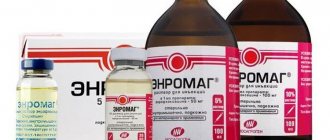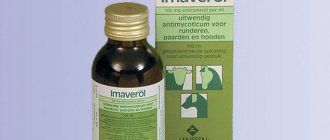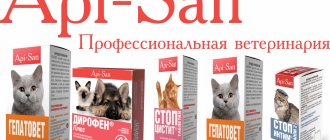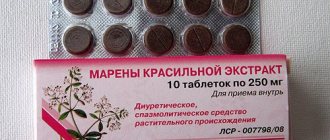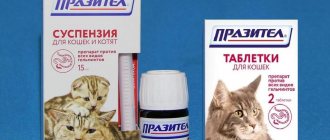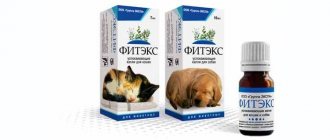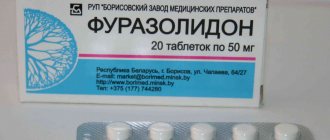Description of the drug Loxicom
Loxicom oral suspension is a non-steroidal drug used in veterinary medicine to relieve inflammation and relieve pain. The international nonproprietary name of the drug is meloxicam. The Loxicom formula was developed by an English pharmaceutical company (Norbrook Laboratories Limited).
The manufacturer positions itself as a world leader in the development and production of innovative products
was established in 1968 in the UK, and now this organization has branches in 30 countries. And veterinary drugs developed by this company are used by animal owners in 120 countries. In order to constantly confirm its right to the title of world leader, Nordbrook Laboratories carries out large-scale work in the field of scientific research, and its production equipment is always the most modern. The company is interested in buyers all over the world, so it produces the developed drugs itself, but on orders from different countries. Thus, Global-Vet LLC supplies Loxicom from the UK to Russia.
Release form of the drug
The dosage form of Loxicom for cats is an oral suspension. Externally, it is a cloudy liquid of light yellow color (uniform suspension). Sometimes the suspension breaks up into a clear solution and a cloudy precipitate, but this can be easily corrected by shaking. The suspension is packaged in transparent plastic bottles with screw caps (5 ml or 15 ml). Each bottle is packed in a cardboard box along with instructions for use and a dispenser syringe.
Recommendations for use are indicated on the end of the box, and the name and volume of the drug, as well as information about the manufacturer, are on the front of the package. The image on the box is made in blue and beige colors. Often on the box there is an image in the form of a gray cat (its absence does not indicate falsification). In addition, the box, bottle and instructions contain information about the release date and expiration date.
Each unit of suspension comes with a convenient syringe with a “mass scale”
Composition of the drug
The composition of 1 ml of Loxicom suspension includes the following components:
- meloxicam - 0.5 mg/ml (active ingredient);
- sodium benzoate (preservative E211);
- glycerol (glycerol derivative);
- povidone K30 (binder for the active substance);
- xanthan gum (provides the release of the active substance into the bloodstream);
- disodium phosphate dihydrate (food additive E339);
- sodium dihydrogen phosphate dihydrate (emulsifier, pH regulator);
- citric acid (food additive E330);
- simethicone emulsion and purified water.
Storage conditions for Loxicom
It is recommended to store the suspension under the following conditions:
- in sealed manufacturer's packaging;
- separately from food and feed;
- in a dry place, protected from light;
- at temperatures from 0°C to 25°C ;
- in places inaccessible to children.
Pay attention to shelf life. The suspension in closed packaging is stored for 2 years, and after the first opening - no more than six months. After the specified period, Loxicom cannot be used; the drug must be disposed of with household waste. The container of the drug cannot be used for domestic purposes.
Loxicom is best stored together with other veterinary drugs in the medicine cabinet.
Indications for use
Loxicom is used as an anti-inflammatory, antipyretic and analgesic agent for the following pathologies:
- pain syndromes of various etymologies;
- diseases of the musculoskeletal system;
- inflammatory processes in soft tissues.
In addition, the suspension is often used during the period of postoperative adaptation.
How does Loxicom suspension work?
The main medicinal property of the suspension is due to the presence of meloxicam in the composition. This substance blocks the production of cycloxygenase, which contributes to the development of inflammatory processes (swelling, pain, etc.).
Meloxicam is absorbed from the gastrointestinal tract into the blood; the highest therapeutic concentration of the substance in the blood is achieved after 4.5–6.5 hours. After a day, meloxicam is eliminated from the body.
Owner reviews
Anna, owner of a 12-year-old cat:
“I noticed that the cat began to limp. I went to the doctor. After X-rays and tests, we were prescribed Loxicom; the exact cause of the lameness was not determined. After the first dose, the cat started vomiting (within a couple of hours). We took a break and then continued. My pet liked the taste of the suspension, but it didn’t solve the problem. The limp remains."
Victoria, owner of the Scottish Fold cat:
“We used Loxicom for our cat, who was diagnosed with dysplasia. The drug slightly improved the pet's condition. He began to move around the apartment without any problems. They used it for 5 days, but the main treatment dragged on for months.”
Features of application
Loxicom is given orally to cats. To do this, you can use a syringe or mix the suspension with a small amount of wet food. The manufacturer recommends using the medicine during feeding.
Important: the bottle of suspension must be shaken vigorously before use.
To ensure that the cat swallows the medicine, it must be poured not into the middle of the tongue, but from the side (close to the cheek and throat).
Table: dosage selection
| Cat body weight | Dose on the first day of treatment | Dose on subsequent days |
| Up to 1 kg | Up to 0.2 ml | Up to 0.1 ml |
| From 1 to 3 kg | From 0.2 to 0.6 ml | From 0.1 to 0.3 ml |
| From 3 to 5 kg | From 0.6 to 1 ml | From 0.3 to 0.5 ml |
Loxicom treatment regimen
Cats should be given the suspension once a day. The course of treatment is determined by a veterinarian. If after 10 days of using the medicine the cat’s condition has not improved, then stop using the drug. If one dose is missed, the course of treatment can be resumed (there is no need to double the dosage).
Despite the fact that the packaging and instructions for using the suspension are presented in Russian, it is still produced in the UK. In this regard, you need to pay special attention to the recommendations. Some cat owners sometimes suspect typos (for example, in the dosage section). Therefore, before using the suspension, consult a specialist (the veterinarian can adjust the treatment regimen you have drawn up).
Loxicom suspension is recommended for use in cats only after consultation with a veterinarian.
Dosage
Loxicom is given strictly as prescribed by a veterinarian to avoid side effects. Designed to relieve postoperative pain and swelling 0.5 mg/ml meloxicam once every 24 hours for up to 4 days. For acute diseases, on the first day of treatment, a dose of 0.2 ml of meloxicam per kg of cat’s body weight should be used, then 0.05 ml/kg while acute pain and inflammation persist.
For chronic cases, the initial single dose of meloxicam is 0.1 ml/kg, followed by a maintenance dose of 0.05 ml/kg once a day. The package with the medicine contains a special syringe with a scale of the active substance by weight, which allows you to calculate the dosage as accurately as possible; one division corresponds to the maintenance dose per kg of animal body weight.
The course of application depends on the condition of the animal and is determined strictly according to the veterinarian’s prescriptions, but not more than 10 days. Clinical response usually occurs within 7 days; if there is no improvement, treatment should be discontinued. Before use, shake the bottle well; sediment may form at the bottom.
pharmachologic effect
Loxicom in the form of an oral suspension belongs to substances of hazard class 3 in terms of effects on the body. Meloxicam, which is part of the main composition of the drug, blocks enzymes that reduce the production of a group of lipid substances, preventing the development of the inflammatory process and reducing pain.
When administered orally, meloxicam is quickly absorbed in the intestine and binds to plasma proteins, which allows you to effectively and quickly combat the source of pain. The maximum daily concentration in the blood occurs after 4.5 hours, but the analgesic effect occurs faster. Meloxicam is localized mainly in the liver and is excreted mainly in bile within 24 hours.
Contraindications and overdose
The most common side effects from using Loxicom in cats are nausea, decreased appetite, lethargy, diarrhea and weight loss. Vomiting blood, increased thirst and frequent urination, abdominal pain or colic are also possible. Such clinical signs may begin with renal failure, which can be caused by the drug in case of overdose, in which case you should immediately consult your doctor.
The drug is contraindicated in pregnant women and lactating women, kittens under 6 months of age, animals in a state of dehydration and chronic heart and kidney diseases. The drug should be used with caution in patients with stomach ulcers and other gastrointestinal diseases, or individual drug intolerance to the components of the drug. If your cat is prescribed meloxicam long term, periodic blood tests are required to monitor for kidney and liver side effects.
Interaction with other drugs
Loxicom is not recommended for use simultaneously with other corticosteroids, such as prednisolone and dexamethasone, as this may increase the likelihood of side effects and negatively affect the kidneys and liver. Heart medications are also ineffective when taking meloxicam; its effect interferes with the dilation of blood vessels in the patient. Due to the risk of bleeding, meloxidine should not be taken with anticoagulants such as heparin.
Overdose
Clinical trials conducted in 2010 proved that there are risks of overdose when using meloxicam. Cats are more sensitive to the drug than dogs, and repeated dosing in the long term can lead to acute kidney failure and even death. Therefore, meloxicam is prescribed only by a veterinarian and is given strictly under his supervision.
Contraindications and possible side effects
The following pathologies are contraindications to the use of Loxicom:
- allergy to meloxicam;
- stomach and duodenal ulcers;
- liver failure and kidney disease;
- hemorrhagic syndrome.
A possible side effect from using the drug may be an allergic reaction to meloxicam. Allergies can be identified by symptoms:
- nausea, vomiting;
- redness on the skin;
- itching, etc.
In such cases, the use of the suspension should be stopped immediately, and it is recommended to show the cat to a veterinarian. In case of severe allergies, the animal will be prescribed antihistamines and symptomatic medications.
Side effects after using Loxicom can be caused by the active substance - meloxicam
What to do in case of overdose
Loxicom is a strong drug, so exceeding the recommended dosage can lead to serious consequences. Signs of overdose:
- nausea, vomiting;
- diarrhea;
- loss of appetite (up to complete refusal to eat);
- weakness, lethargy, apathy;
- bleeding, gastrointestinal ulcers (blood in the stool).
There are no special drugs to eliminate signs of overdose. If these symptoms appear, the cat owner should immediately stop using the suspension. The cat is prescribed symptomatic medications (in some cases, maintenance therapy is needed, for example, drips with saline or glucose).
First aid kit for pain
Magnetic therapy. This method of physiotherapy came to veterinary medicine from medicine. Magnets methods effectively relieve inflammation and alleviate pain in many diseases. Special “harnesses” have been created for cats, allowing the plates to be firmly secured to almost any place on the body.
If your cat is in severe pain, it needs immediate and effective help. First of all, it is important to stabilize the functioning of the heart and improve the supply of oxygen to tissues. This is why pain relief medications are needed. However, many owners do not know what painkillers can be given to cats.
One of the safest non-steroidal analgesics is considered to be ordinary aspirin, also called acetylsalicylic acid. It must be used with caution. Some cats, when taking aspirin, begin to vomit, increase salivation, and develop a depressive state. In case of an overdose, the animal loses its appetite and its acid-base balance is disturbed. There may be problems with coordination of movements. Sometimes there are even signs of gastrointestinal bleeding.
We suggest you read: The puppy has a swollen belly
Loxicom is quite safe as a pain reliever. It is produced in the form of a suspension and injected into the animal’s mouth with a dispenser syringe. The advantage of Loxicom is the convenience of dosage; in addition, it is eliminated by the body quite quickly. In case of overdose, vomiting, diarrhea, and allergic reactions are possible.
From the tablet preparations in the household first aid kit, it is permissible to use pentalgin, spasmalgon, naise, ketorol, and sedalgin.
We suggest you read: Determination of live weight of pigs by measurements
Personal safety measures when in contact with the drug
The manufacturer recommends adhering to the following rules:
- direct contact with the medicine is prohibited for people allergic to antibiotics;
- Do not eat, drink or smoke while working with Loxicom;
- if the suspension gets on the skin or mucous membranes, it should be washed off with running water;
- After handling the medicine, hands should be washed with soap;
- If you have an allergy, you need to go to the hospital (take the bottle or instructions with you).
Contact with Loxicom is contraindicated for people who are allergic to antibiotics.
Drug analogues
The closest analogues of Loxicom are drugs containing meloxicam:
- Meloxivetum;
- Meloxidil;
- Metacam, etc.
Photo gallery: Loxicom analogues
Meloksivet is produced in different countries, but the developer is Belkarolin LLC (Belarus)
The developer of Meloxidil is the French organization Ceva Sante Animale
Metakam formula developed (Germany)
Comparison table: Meloxivet, Meloxidil and Metacam
| Name | Action provided | Release form | Indications | Contraindications | Price |
| Meloxivet 2% | Anti-inflammatory, analgesic, antipyretic, anti-edematous effect | Solution for subcutaneous and intramuscular injections | Inflammatory processes and pain syndromes of various origins | Allergy to meloxicam, liver and kidney diseases | From 500 rubles per bottle (50 ml) |
| Meloxidil | Suspension for oral administration | Diseases of the musculoskeletal system | Intolerance to components, diseases of the gastrointestinal tract, heart, liver and kidneys, pregnancy | From 800 rubles per bottle (10 ml) | |
| Metacam | Solution for subcutaneous and intravenous injections | Diseases of bacterial etiology and inflammatory processes in diseases of the musculoskeletal system | Allergy to meloxicam, gastrointestinal ulcers, liver, kidney and heart damage, hemorrhagic syndrome | From 900 rubles per bottle (100 ml) |
Storage conditions
Storage conditions recommended by the company producing the medicine are as follows: Loxicom should be stored in closed and undamaged packaging issued by the manufacturer; the storage place must be dry, without access to light, and it cannot be located next to food and animal feed; optimal storage temperature from 0 to 25°C; it is necessary to ensure that the drug is not accessible to children and animals. The drug Loxicom, of course, has analogues. All of them contain meloxicam as the main substance. For example, for comparison: Meloxivet 0.2% (Belarus) - a solution for injection use that costs about 500 rubles; Meloxidil (France) – suspension for oral administration, about 800 rubles; Metacam (Germany) – injection solution, about 900 rubles. The drug Loxicom has an impressive number of contraindications, so it should be offered to your beloved cat with caution and only under the supervision of a specialist. You should not treat your pet yourself.
Visit the profile section of our Medical Examination forum or leave your feedback in the comments below. More opinions means more useful information, it will be useful to someone. If there are good and interesting videos on the topic of the article, write and I will insert them into this publication.
